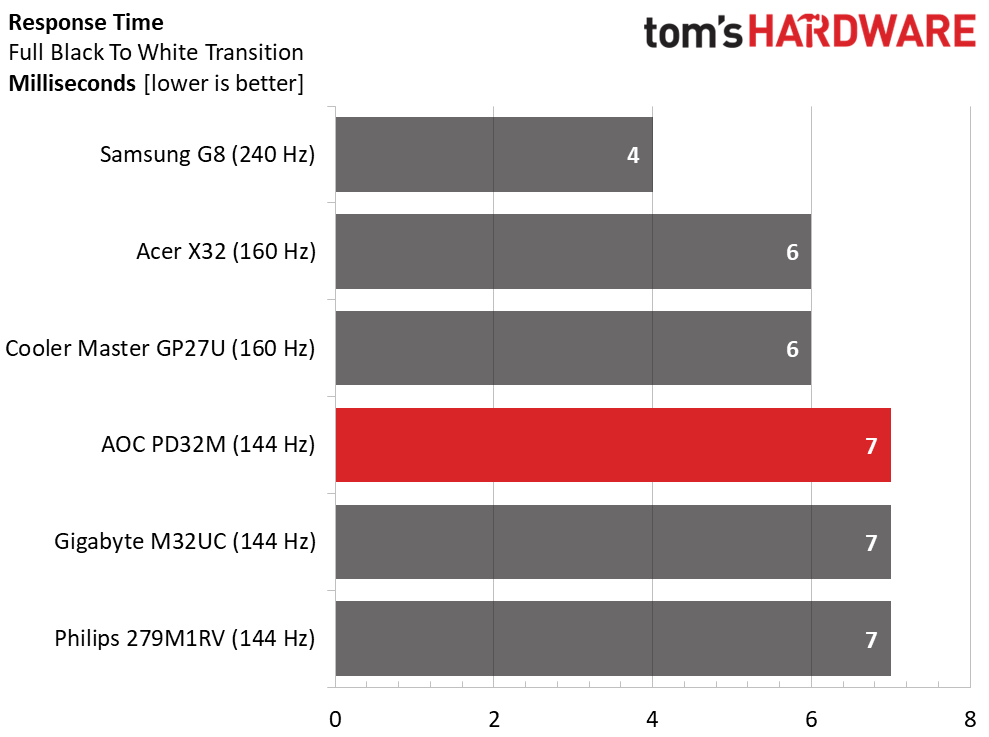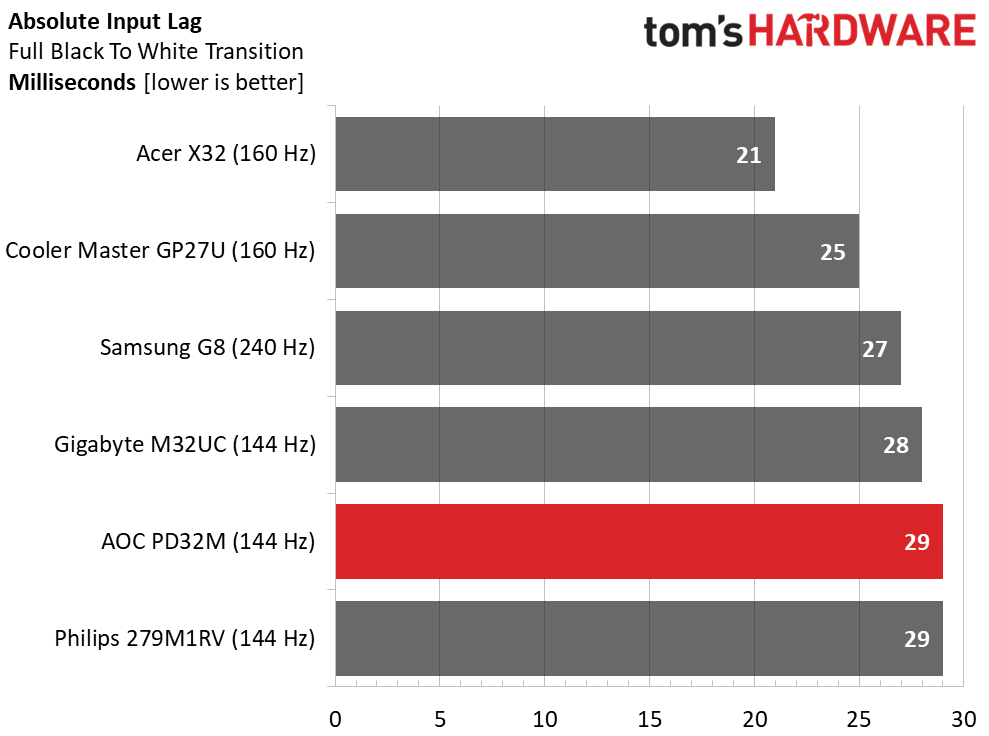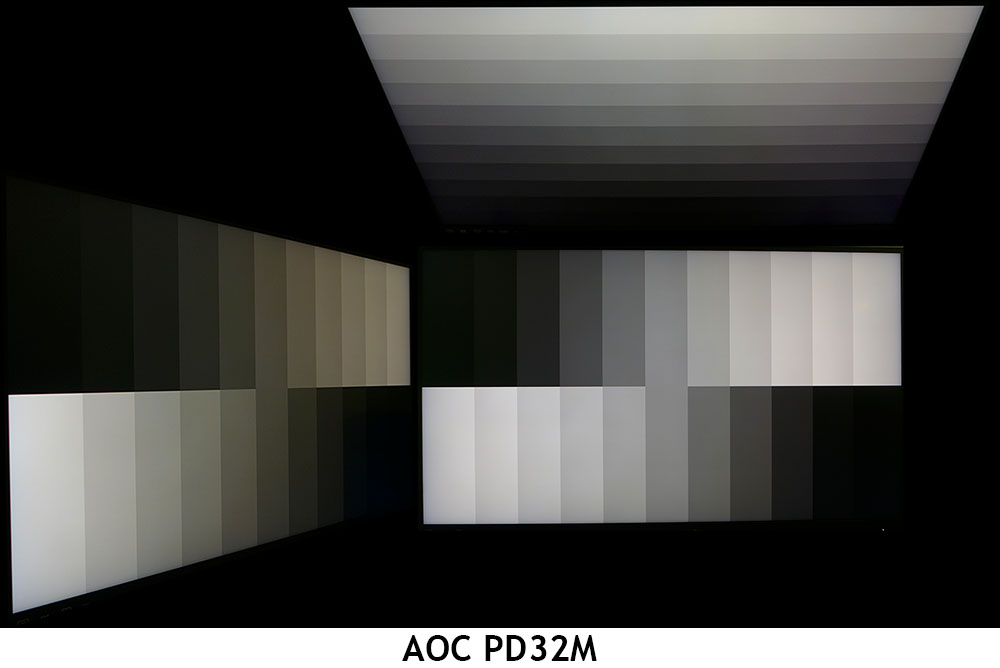Why you can trust Tom's Hardware
The PD32M’s gaming performance is on par with the better 4K screens I’ve tested. To compare it, I’ve lined up the Gigabyte M32UC and Philips 279M1RV, which refreshes at 144 Hz like the AOC. At 160 Hz is Acer’s X32 and Cooler Master’s GP27U. Sitting alone on the throne is Samsung’s Neo G8 which still has no speed equal at this resolution.
Pixel Response and Input Lag
Click here to read up on our pixel response and input lag testing procedures.


Panel response goes hand in hand with refresh rate as the PD32M, and the other two 144 Hz screens all draw a full white field in 7ms. These three panels will all deliver the same motion resolution and the same level of blur, which is minimal but less smooth than the 160 and 240 Hz models. The AOC’s overdrive is good but not great. On its Weak setting, there is a tiny bit of ghosting, which is hard to spot in game content.
The PD32M is at the back of the pack in the input lag test. This is not a negative, 29ms is pretty quick for all but the most skilled players. Gamers of average ability will have no complaints about control response. If you’re looking for a competition monitor in 4K resolution, the Acer X32 is the fastest I’ve tested, beating even the Samsung G8 for overall responsiveness.
Viewing Angles
The PD32M is an average IPS panel in the viewing angle test where you’ll see a slight red/green shift at 45 degrees off axis. Light falloff is minimal though and there is no significant change in gamma or detail visibility. The top view is good too with clear detail, almost no change in color, and a slight brightness reduction.
Screen Uniformity
To learn how we measure screen uniformity, click here.
The PD32M slayed my uniformity test, scoring one of the lowest results I’ve ever recorded. 3.62% is way below the visible threshold. Though a uniform compensation feature is hiding in the OSD, it’s completely unnecessary.
Get Tom's Hardware's best news and in-depth reviews, straight to your inbox.
MORE: Best Gaming Monitors
MORE: How We Test PC Monitors
MORE: How to Buy a PC Monitor
MORE: How to Choose the Best HDR Monitor
Current page: Response, Input Lag, Viewing Angles and Uniformity
Prev Page Features and Specifications Next Page Brightness and Contrast
Christian Eberle is a Contributing Editor for Tom's Hardware US. He's a veteran reviewer of A/V equipment, specializing in monitors. Christian began his obsession with tech when he built his first PC in 1991, a 286 running DOS 3.0 at a blazing 12MHz. In 2006, he undertook training from the Imaging Science Foundation in video calibration and testing and thus started a passion for precise imaging that persists to this day. He is also a professional musician with a degree from the New England Conservatory as a classical bassoonist which he used to good effect as a performer with the West Point Army Band from 1987 to 2013. He enjoys watching movies and listening to high-end audio in his custom-built home theater and can be seen riding trails near his home on a race-ready ICE VTX recumbent trike. Christian enjoys the endless summer in Florida where he lives with his wife and Chihuahua and plays with orchestras around the state.
-
UWguy Did April fools come twice this year? If this was OLED maybe it would justify the price but definitely not as is.Reply
Plus AOC? Gives me flashbacks to the 80’s with their crappy interference laden CRT monitors. -
oofdragon ReplyUWguy said:Did April fools come twice this year? If this was OLED maybe it would justify the price but definitely not as is.
Plus AOC? Gives me flashbacks to the 80’s with their crappy interference laden CRT monitors.
Well this is a advertising website, not a review one.. so you have these amazing products left and right. I do agree that as of today I wont buy a expensive monitor if it's not OLED. They say "but Mini led is brighter!! " Bro I turn brightness down the most I can, I don't want to look at a super bright lamp but at pure black, and make it 240Hz because today that's the new standard -
jakjawagon ReplyThere is no KVM switch, unfortunately.
Yes there is. The monitor's USB ports will connect via either the USB-C port or the USB-B upstream port, depending on which display input is active. Not the most elegant solution, but it's still technically a KVM.
A tiny dongle plugs into one of the USB ports to support the wireless remote.
I'm guessing you're mistaking the included USB stick containing drivers, manuals etc. for a dongle. The remote works fine without plugging it in. -
ra3tonite I have a 1440p monitor but I still play games at 1080p. A lot of games look really great 1080p when playing on a native 1080p monitor. But when I use my 1440p monitor and scale back to 1080p, I notice that the image is not as sharp as when just playing on a native 1080p monitor.Reply
I wonder if using a 4k monitor but scaling back to 1080p for games would have that same blurring effect? Not sure since 2160p to 1080p is a cleaner ratio compared to 1440p to 1080p. I'm not really sure how that stuff works, though. Any thoughts?


